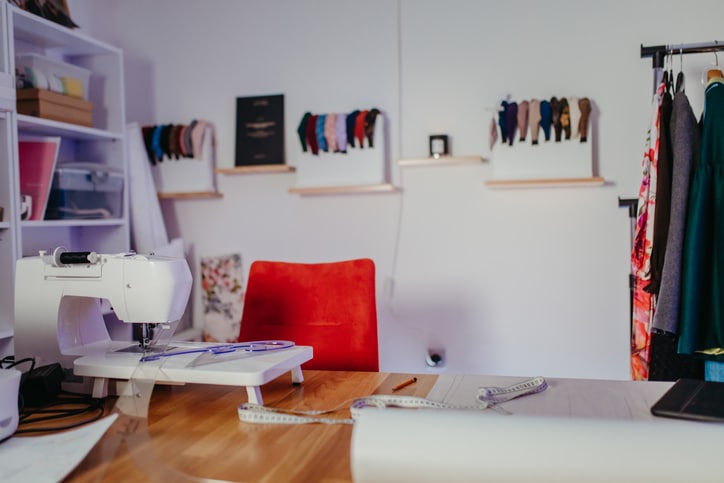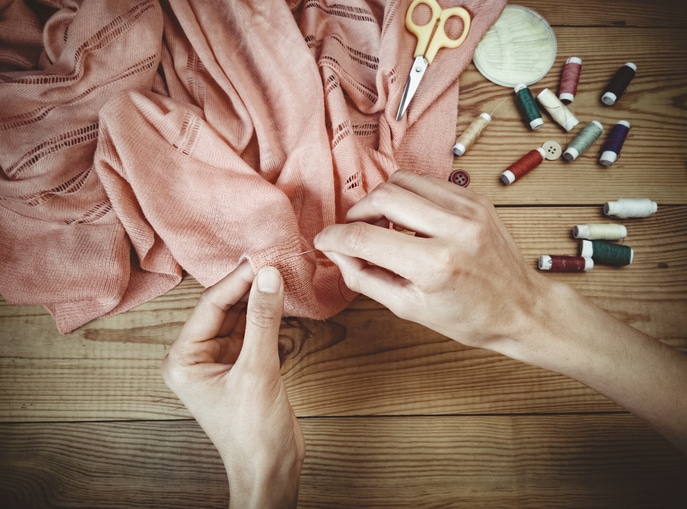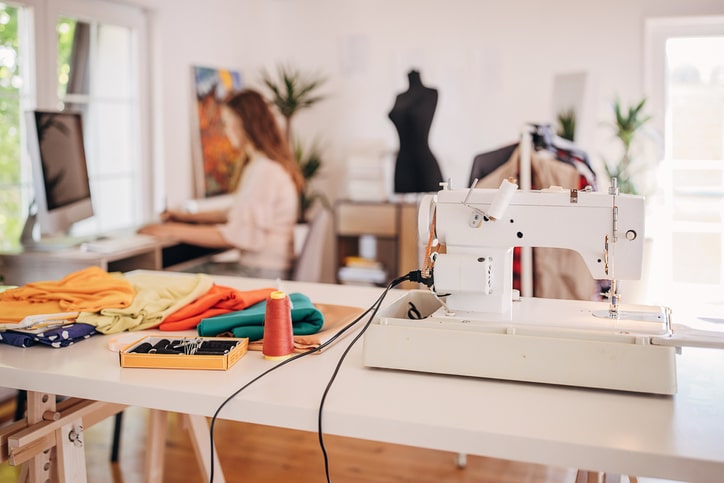Maybe you want to start sewing your own clothes to cut down on fast fashion intake. Maybe your grandmother used to sew, but you never learned from her. Maybe you’re just ready for a new hobby!
Getting started can be intimidating, no matter why you want to learn to sew. How do you know what sewing machine to choose and what patterns are within your skill level? What do you need to start sewing, and what can you do without?
In this article, we will guide you through learning to sew independently. Whether you’re a beginner or have some experience with a needle and thread, this article will give you resources that will help you learn, grow, and sew.
Getting Started With Sewing
If you’ve browsed the sewing side of Pinterest for even a few minutes, you know there’s more than meets the eye when it comes to sewing. You have to find the right kind of machine, learn how to operate it, pick the right kind of fabric, and that’s all before you even think about a sewing project!
Here are the first steps before embarking on your sewing journey.
Which Sewing Machine is Right for You?
When picking a sewing machine, consider your budget and what you want to make. It’s not unwise to start with a beginner sewing machine, but expect to upgrade if you want to sew fancier stitches, make quilts, or work with heavier fabrics.
You might choose a “starter” sewing machine in the $100-$150 range as a beginner. These machines – the kinds you can usually find at Walmart and Target – are designed for novices and are relatively inexpensive. You want to pick a sewing machine with small features that make learning easier – things like automatic needle threading can make the difference between a fulfilling learning experience and a stressful one.
If you’re replacing a beginner sewing machine or looking to invest in a more high-tech one, look into computerized sewing machines. These high-tech machines often have extra features that help make your stitches look professional and have become relatively affordable in recent years. A computerized Brother sewing machine, for example, retails for as low as $200.
Depending on your projects, you may also look into a sewing machine with specialty settings, like quilting or embroidery. Quilting machines usually have a larger working area, allowing the fabric to keep flat while you sew. Embroidery machines can have many specialty stitches and open up many artistic and customization opportunities.
What Tools and Supplies are Necessary for Beginning Sewists?
So you’ve picked the perfect sewing machine – what else do you need? When assembling your sewing toolkit, include a selection of sewing notions. These items help streamline your sewing projects and ensure you have everything you need at your fingertips.
First and foremost, invest in various sewing machine needles suitable for different fabrics and project types. Universal needles are a good starting point. It’s also wise to keep some hand-sewing needles when you want to do fine detail work, or it’s easier to seam something up by hand.
Don’t forget to stock up on primary thread colors like black, white, and neutral shades, and match your thread to your fabric for a polished finish. A sharp pair of fabric scissors is a must-have, and it’s crucial to designate them solely for fabric cutting to maintain their sharpness. Learning to hone and sharpen your sewing scissors is not a bad idea, either.
Pins and a pin cushion are handy for holding fabric pieces together before sewing, while a measuring tape ensures accurate measurements for your projects. A seam ripper is a valuable tool for correcting mistakes without damaging your fabric.

Preparing and Organizing Your Sewing Workspace
Like any other craft or hobby, sewing is easier when you have an organized and uncluttered space in which to do it. But sewing materials aren’t exactly compact – bolts of fabric take up space, cutting boards can be bulky, and the sewing machine itself isn’t exactly small! This is why specialized sewing furniture exists.
The first thing you should invest in when designing your dedicated sewing space is a sizeable sewing table and cabinet to hold your sewing machine and notions. You’ll also want to invest in a solid cutting surface that can hold large swaths of fabric – a specialized cutting table can store your notions and fabrics and be functional.
Finally, you must designate a space to hold your fabrics and patterns. A bin or basket can hold fabric scraps and fat quarters. For longer bolts of fabric, though, look into a dedicated fabric organizer. A drawer in a larger sewing cabinet can be set aside to hold patterns and templates.
If you fall in love with sewing, it’s worth it to invest in a robust storage and organizational system for your dream sewing room. For how much time you’ll spend in there, you’ll truly benefit from a clean and organized space.
Basic Sewing Techniques for Beginners
Before making the fancy garments and patterns you’ve been eyeing online, you must master the sewing basics. These skills will serve as the building blocks for your sewing prowess – every skill you learn from here on out will be based on these.
Threading the Sewing Machine
Before you can begin sewing, you must learn to thread your sewing machine correctly. As many sewists will tell you, this is easier said than done – especially when you’re a beginner!
Consult your sewing machine’s manual for specific instructions, as different machines may have unique threading processes. Typically, this involves winding the bobbin, guiding the thread through various tension disks, and threading the needle. It may be tricky initially, but practice threading and rethreading your needle until it feels familiar and intuitive.
Sewing Straight Seams
One of the fundamental skills in sewing is stitching straight seams. Your hands may pull the fabric out of alignment, or your stitches may veer over time.
When you’re still learning how to work your sewing machine, practice sewing lines on scrap fabric. Start by aligning the fabric edge with your desired seam allowance. Lower the presser foot and guide the fabric through the machine with a steady hand while maintaining an even seam allowance. Practice makes perfect, so don’t be discouraged if your first attempts aren’t flawless. With time, you’ll develop a steady hand and achieve perfectly straight seams.

Hand Stitching
While sewing machines are incredibly efficient, knowing how to hand stitch is a valuable skill. Hand stitching is ideal for intricate details, repairs, or when a sewing machine isn’t suitable. Learn basic hand stitches like the running stitch, backstitch, and slip stitch. These stitches are essential for tasks such as attaching buttons, mending seams, or adding decorative embellishments to your creations.
Understanding Sewing Patterns
Sewing patterns are like roadmaps for your projects. They provide instructions on how to cut fabric and assemble pieces to create a finished garment or item. However, reading sewing patterns may feel more like translating ancient documents when you’re learning to sew!
Start with simple patterns designed for beginners, and read through the instructions carefully before beginning. Pay attention to pattern markings, grainlines, and notches. Some YouTube creators will post “sew-alongs” with specific patterns – it may help you to watch someone sew the same pattern as you.
You can explore more complex patterns and experiment with alterations and customizations as you become more skilled.
Hemming or Mastering Finishing Touches
Hemming is the finishing touch that gives your projects a polished appearance. To hem, fold the fabric edge over, encasing the raw edge, and then stitch it in place. Practice hemming on different fabric types to get a feel for how they behave. You’ll encounter various hemming techniques, including blind hemming, rolled hems, and narrow hems, each suited to different applications.
Simple Beginner Sewing Projects
- Patchwork Apron: This sweet rustic apron is made of separate patches of fabric, making this great for using up leftover fabric scraps.
- Comfy Pajama Shorts: These shorts are a great introduction to sewing garments. If you’re new to cutting and shaping fabric before you sew it, try these shorts.
- Simple Tote Bag: Who couldn’t use another tote bag? This simple pattern can be worked up in less than a day and makes a great gift.
- Embroidery Hoop Organizer: Sew something to make your sewing easier! This embroidery hoop organizer is perfect for when you have a lot of little scraps of fabric to use up. Hold your notions close with this cute project.
- Button-Down Collared Shirt: Got a fun fabric and want to test your garment-making skills? Try this button-down collared shirt! These shirts are trendy and great for flexing your advanced beginner skills.
Best Sewing Books for Beginners
- The Reader’s Digest Complete Guide to Sewing: This book is updated yearly with new information, tips, and tricks. If you want, you can find a vintage version of the book – the advice may be outdated but will still be trustworthy. If you only buy one sewing book, make it this one.
- S.E.W. Sew Everything Workshop: Diana Rupp’s clever and captivating writing makes this book as fun as it is informative. The patterns are designed with modern trends in mind, and you’ll learn to sew by making things you want to wear.
- The Palmer/Pletsch Complete Guide to Fitting: When you start making garments, it’s essential that you understand how to measure and fit clothes effectively. This book is the most detailed guide to fitting in the world – you’ll be glad to have this on your shelf when needed.
- Ahead of the Curve: Jenny Rushmore, founder of Cashmerette, has dedicated herself to making sewing more accessible to curvy and plus-sized people. This book is all about finding good plus-sized patterns, learning how to measure larger bodies, and how to sew flattering clothes for all sizes.
- Bend the Rules Sewing: Like any good craft, sewing has rules you must follow and some rules you can bend for better results. This book talks about the latter. Amy Karol approaches sewing with a fun-first, devil-may-care attitude that you will find freeing.
If you’d like to dive into more reading material to elevate your sewing skills, check out our recommendations of the 25 essential sewing books for beginners.

Sewing Classes for Beginners
As you begin to master the beginner skills and start to want more personalized instruction, you may look into sewing classes. These classes have the benefit of giving you more personalized attention, and you can get expert answers to your questions in real time.
To find in-person classes in your area, visit local fabric and craft stores and ask about their offerings. Many local craft and supply shops offer lessons and more formal classes, and you’ll get the benefits of being treated like a regular customer afterward.
If online classes are more your speed, look into websites like Skillshare or Masterclass to learn to sew. You can also find a wealth of tutorials on YouTube for specific techniques you may be struggling to master. Seeking more guidance and instruction is always valuable to sewists!
Additional Resources for Beginning Sewists
- The Sewing Subreddit: This forum, known as a “subreddit,” is a great place to convene with other sewists, ask questions, and get inspiration. There is also a lengthy resource list in the sidebar.
- The Curvy Sewing Collective: If you’re a plus-sized or curvy sewist, you know the unique challenges of finding patterns that fit. This blog offers advice on resizing, links to plus-sized patternmakers, and community forums for discussing sewing with like-minded people.
- Sew It! Academy: This site offers a multitude of sewing courses aimed at sewists of all skill levels. The videos are well-produced and informative and easily guide you through concepts and patterns.
- Sewing.com: This eponymous site sells patterns and tutorials and publishes new sewing-related content daily to keep you in the know.
- Skillshare: We mentioned this site earlier, but it’s also worth highlighting here. Skillshare is like YouTube for learning new skills – experts produce high-quality videos on any topic they know a lot about. The sewing corner of Skillshare is worth checking out!
With some practice and dedication, you will be well on your way to becoming an intermediate and even advanced sewist. Doing thorough research and finding the right classes and instructions for how you work will make the difference between a fulfilling learning experience and one you never try again. Whether you’re pursuing sewing as a practical skill or a passion, the skills you acquire and the projects you complete will be a testament to your dedication and creativity.
Elevate Your Sewing Experience to be More Efficient and Enjoyable
To make your sewing experience more enjoyable and efficient, consider exploring specialized sewing furniture from Arrow Sewing. We offer a range of sewing cabinets and tables designed to enhance your sewing workspace, providing ample storage for your sewing machine, notions, and fabrics. Browse Arrow Sewing’s catalog to discover our selection of sewing furniture and take your sewing journey to the next level. Happy sewing!
